As a judge in a local cooking competition in Bulacan last year, I was completely blown away when one of the contestants served Pinangat na Talimusak, a dish that instantly transported me back to my childhood summers spent in my grandmother's home.
This humble river fish, transformed into something so incredibly flavorful, ended up winning not just the competition, but also a permanent spot in my cooking rotation.
Like many Filipino dishes, it's amazing how a few simple ingredients: fresh talimusak, ripe tomatoes and bright calamansi, can create such a deeply satisfying meal.
The best part about this recipe is how forgiving it is. You'll be surprised at how easy it is to recreate this classic Filipino dish.
I've perfected this recipe to capture that perfect balance of flavors that makes Pinangat na Talimusak so special.
What is Talimusak?
Talimusak (Glossogobius giuris) is a freshwater goby fish found in Philippine rivers. It's known by various names across the Philippines, including Batlungan (Bicol), Kibot (Bataan), Piyagot/Piyosan (Aklan), and others such as Birut, Bukto, Palileng, Mori, Udingan, Ilongan, and Halungan.
Jump to:
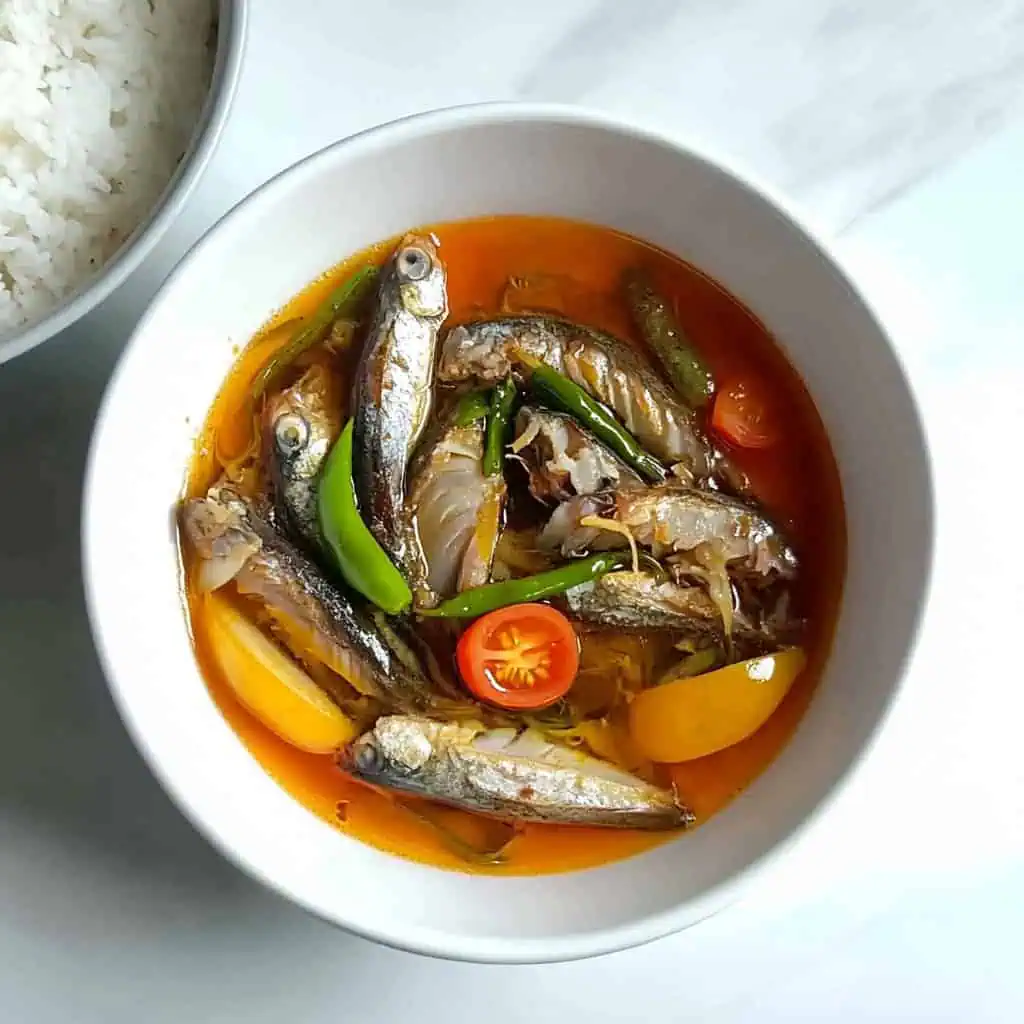
Why You'll Love This Recipe
- Authentic Filipino flavor that brings memories of traditional home cooking
- Simple, wholesome ingredients that are easily accessible
- Perfect balance of sour and savory flavors
- Healthy, protein-rich meal that's light yet satisfying
- Budget-friendly dish that feeds the whole family
- Versatile recipe that allows for different variations
Ingredients
The ingredients in this recipe create a beautiful harmony of flavors that perfectly complement the delicate talimusak fish. Ripe tomatoes provide natural sweetness and acidity while breaking down to create the stew's base. Onions and ginger add aromatic depth that enhances the fish without overpowering it.
Calamansi juice introduces that signature Filipino sourness that balances the dish and helps tenderize the fish. Rice washing water, an ingenious traditional element, adds subtle starchiness and nutrients that would otherwise be wasted. The whole green chilies contribute gentle heat that can be adjusted by removing them earlier if desired.
Finally, the small amount of oil creates those distinctive orange droplets that signify an authentic pinangat, adding richness to the light, flavorful broth.
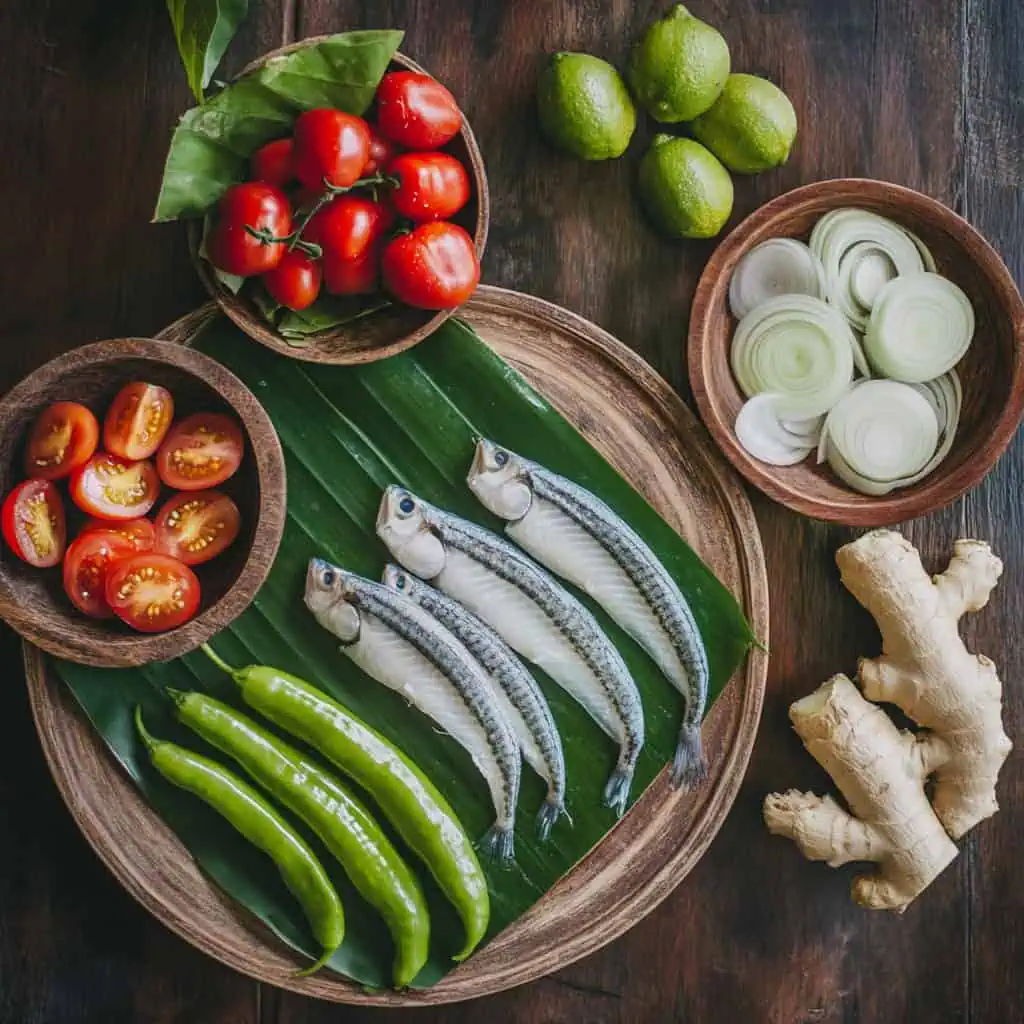
- 500g talimusak (goby fish), cleaned and salted
- 3-4 large tomatoes, sliced
- 1 medium onion, sliced
- 1 thumb-sized ginger, peeled and chopped
- ½ cup calamansi juice
- 2 cups rice washing water (hugas bigas)
- 1 teaspoon salt
- 4 pieces long green chilies (siling haba)
- 2 tablespoons vegetable oil
Equipment
- Large pan or kawali (deep frying pan) - For properly stewing the fish and allowing enough space for the broth to develop
- Sharp knife - Essential for precisely cutting vegetables and preparing the fish
- Cutting board - Provides a clean, stable surface for preparation
- Measuring cups and spoons - Ensures recipe accuracy and consistency
- Fish turner/spatula - Designed with slots to handle delicate fish without breaking it
- Deep serving bowl - Ideal for serving stew with its flavorful broth
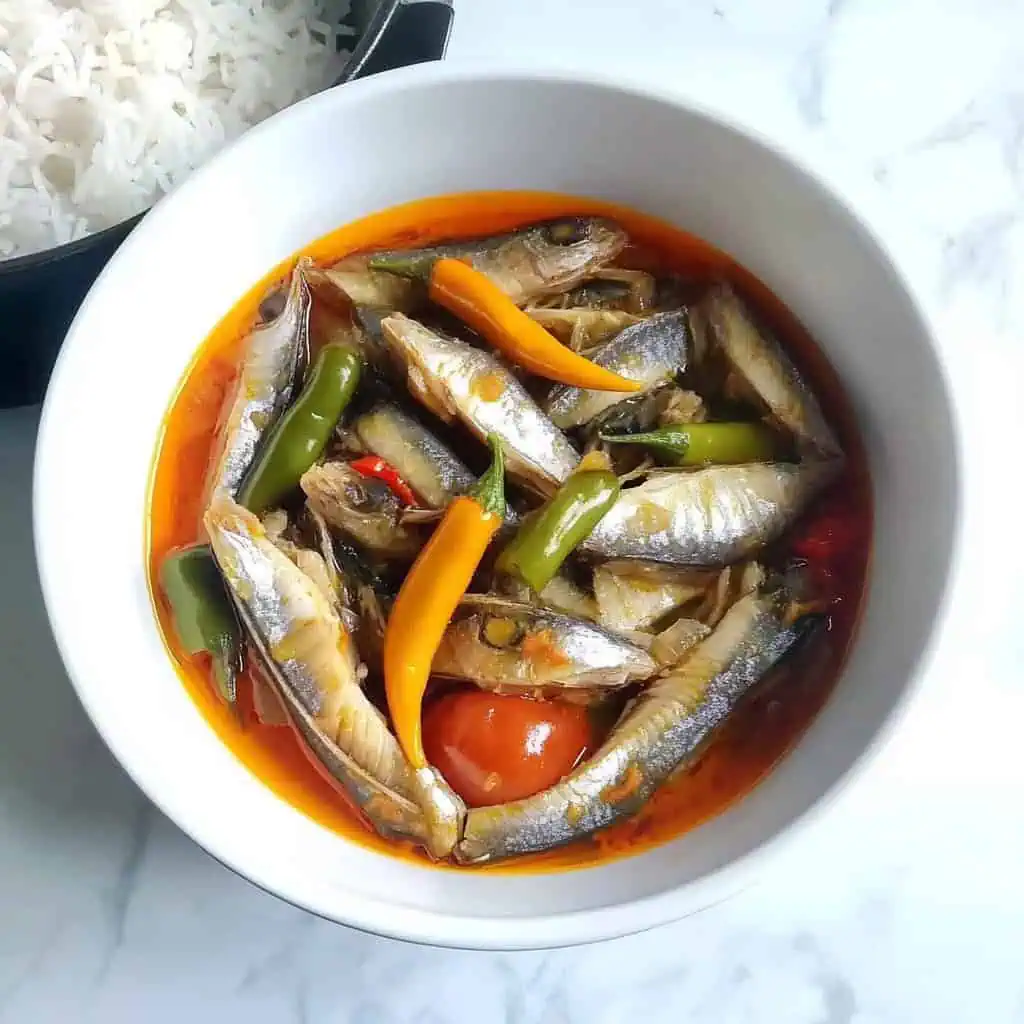
How To Make
- Heat your pan over medium heat and create a flavorful base by arranging half of your sliced tomatoes in an even layer at the bottom. Scatter half of your sliced onions and chopped ginger over the tomatoes – this layer will release its juices and create an aromatic foundation for your fish.
- Place your cleaned and salted talimusak carefully on top of the vegetable layer. The fish should be arranged in a single layer to ensure even cooking. Top the fish with your remaining tomatoes, onions, and ginger, then pour the fresh calamansi juice evenly over everything. Add the whole siling haba around the pan.
- Pour the rice washing water into the pan, making sure not to disturb your carefully arranged layers. Let everything come to a gentle boil over high heat. Once boiling, drizzle the vegetable oil over the top – this will create those beautiful orange dots of oil in your sauce that's characteristic of authentic pinangat.
- Reduce the heat to low, cover the pan, and let everything simmer gently for 15-20 minutes. The fish should cook slowly to absorb all the flavors while staying intact. Your sauce will gradually turn into that signature reddish-orange color with spots of oil on top. Resist the urge to stir, as talimusak is delicate and can break apart easily.
- After 15-20 minutes, check if the fish is cooked through – it should be opaque and flake easily. The tomatoes should be soft and the sauce should have reduced slightly, becoming more flavorful. If the sauce is too thin, simmer uncovered for a few more minutes. Taste and adjust the seasoning with salt if needed.
- Turn off the heat and let your pinangat rest for about 5 minutes. This resting period allows the flavors to settle and the fish to absorb more of the sauce. Carefully transfer everything to a deep serving bowl, making sure to get all the sauce. Serve hot with steamed rice and extra patis on the side for those who want an extra punch of flavor.

Tips from Lola's Kitchen
- The Rice Washing Secret: Always use rice washing water (hugas bigas) instead of regular water. This not only reduces waste but adds subtle starch and nutrients that enrich your broth.
- Layering Technique: The order of ingredients matters—always start with tomatoes on the bottom as they release juices that prevent sticking and create a flavorful base.
- Minimal Stirring: Once everything is in the pan, avoid excessive stirring. Talimusak is delicate and will fall apart easily.
- Resting Period: Let the dish rest for 5-10 minutes after cooking. This allows the flavors to meld and the fish to absorb more of the broth.
- Oil Drizzle Timing: Add the oil only after the broth begins to boil—this creates those beautiful orange droplets that signify authentic pinangat.
Substitutions
- Fish: If talimusak is unavailable, substitute with tilapia, bangus (milkfish), or any firm white fish. Just adjust cooking time accordingly for larger fish.
- Calamansi: White vinegar mixed with a little lemon juice works well. Use 3 tablespoons vinegar + 1 tablespoon lemon juice to replace ½ cup calamansi juice.
- Rice Washing Water: Regular water will work, but add ½ teaspoon fish sauce to compensate for lost flavor.
- Siling Haba: Use bell peppers for less heat or bird's eye chilies (siling labuyo) for more heat (but use fewer).
- Fresh Tomatoes: Canned tomatoes can work in a pinch—use 1 can (14 oz) diced tomatoes, drained.
Troubleshooting
- Fish Breaking Apart: Your heat may be too high or you might be stirring too often. Lower heat and minimize movement of the fish during cooking.
- Too Sour: Add ½ teaspoon of sugar to balance acidity without compromising the dish's character.
- Too Bland: Add fish sauce (patis) 1 teaspoon at a time until desired flavor is reached.
- Watery Broth: Remove lid and simmer for 5-7 additional minutes to reduce liquid.
- Bitter Aftertaste: Ginger may be overcooked. Next time, add ginger midway through cooking process instead of at the beginning.
- Fish Not Cooking Evenly: Ensure all fish pieces are similar in size and thickness for consistent cooking.
Storage & Reheating
- Refrigeration: Store in an airtight container for up to 2 days. The flavor actually improves overnight as the fish absorbs more of the broth.
- Freezing: Not recommended as the fish texture will deteriorate and tomatoes will become mushy.
- Reheating: Warm gently over low heat until just heated through—about 5 minutes. Avoid boiling as this will break apart the fish.
- Freshening: Add a squeeze of fresh calamansi when reheating to brighten flavors that may have dulled during storage.
- Serving After Storage: If the broth has thickened in the refrigerator, add 1-2 tablespoons of hot water when reheating.
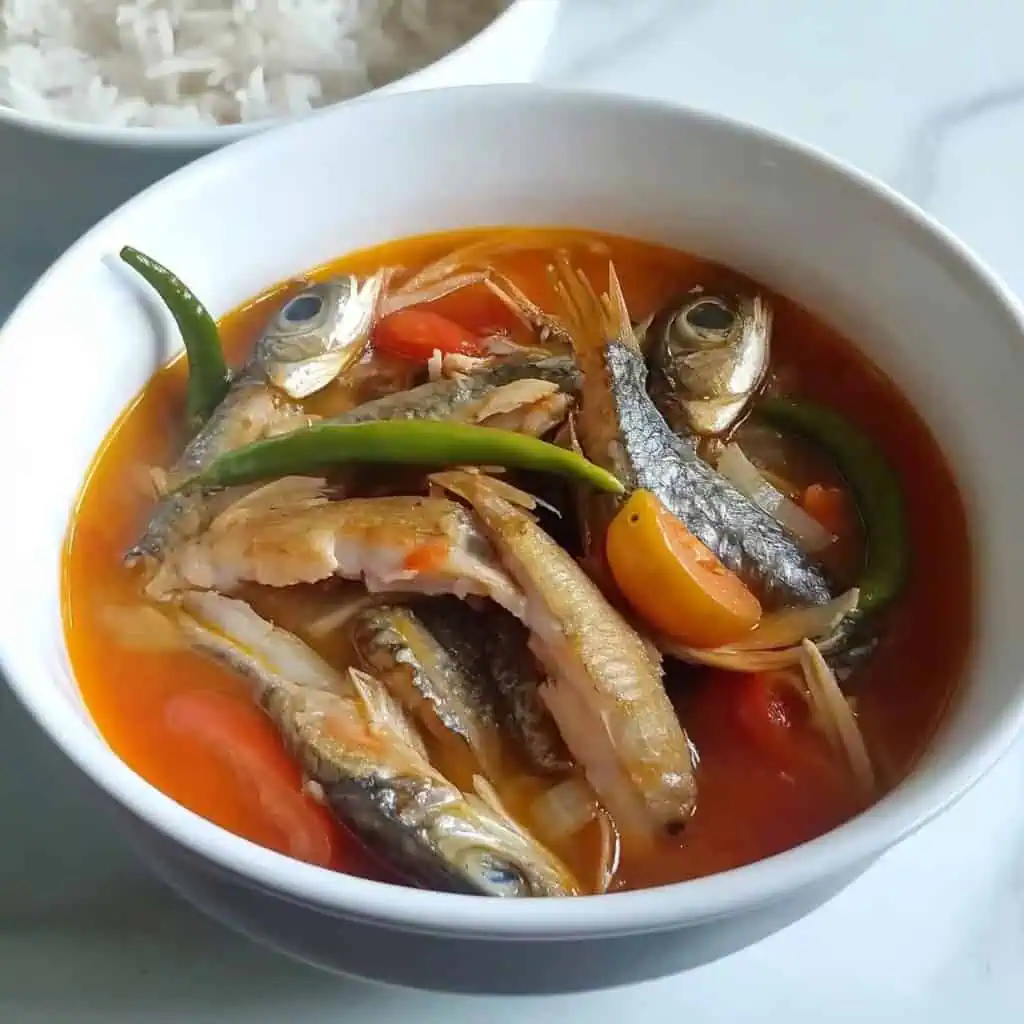
FAQ
Can I make Pinangat na Talimusak with frozen fish?
Yes, but thaw completely and pat dry before using. Frozen fish releases more water, so you may need to reduce the amount of rice washing water by about ¼ cup.
How spicy is this dish?
With whole siling haba (long green chilies), it's mildly spicy. For less heat, remove seeds before cooking or omit entirely. For more heat, slice the chilies to release more capsaicin.
Can I add vegetables to make it healthier?
Absolutely! Spinach, kangkong (water spinach), or eggplant work well. Add leafy greens in the last 2 minutes of cooking, or heartier vegetables like eggplant with the tomatoes.
What's the difference between Pinangat and Paksiw?
Pinangat uses fresh ingredients and calamansi for sourness, while Paksiw primarily uses vinegar and sometimes includes pre-fried fish.
Is this dish healthy?
Yes! It's low in fat, high in protein, and contains antioxidants from tomatoes and ginger. The minimal oil makes it heart-healthy.
Why use rice washing water instead of regular water?
Rice washing water contains nutrients and starches that add body and subtle flavor to the broth. It's also a sustainable practice that reduces waste.
Can I make this dish ahead for a party?
It's best made fresh, but you can prepare it up to 4 hours ahead and reheat gently. The flavor may even improve, but the fish texture is best when freshly cooked.
What wine pairs well with this dish?
A dry Riesling or Pinot Grigio complements the sour and savory flavors without overwhelming the delicate fish.
Related
Looking for other recipes like this? Try these:

Pinangat na Talimusak (Filipino Goby Fish Stew)
Equipment
- Large pan or kawali (deep frying pan) for stewing the fish
- Sharp knife (kutsilyo) for preparing vegetables
- Cutting board (Sangkalan) for chopping ingredients
- Measuring cups and spoons (Panukat) for precise ingredients measurement
- Fish turner/spatula (sandok) for gentle handling of fish
- Serving bowl (mangkok) preferably deep for the broth
Ingredients
For the Fish:
- 500 g talimusak goby fish, cleaned and salted
- Filipino: talimusak na nilinis at inaasinan
- Alternative fish: bisugo bangus, or any firm white fish
For the Broth Base:
- 3-4 large tomatoes sliced
- Filipino: kamatis na hiniwa
- 1 medium onion sliced
- Filipino: sibuyas na hiniwa
- 1 thumb-sized ginger peeled and chopped
- Filipino: luya na tinadtad
- ½ cup calamansi juice
- Filipino: katas ng kalamansi
- 2 cups rice washing water hugas bigas
- Filipino: tubig na pinaghugasan ng bigas
- 1 teaspoon salt
- Filipino: asin
- 4 pieces long green chilies siling haba
- Filipino: siling haba
- 2 tablespoons vegetable oil
- Filipino: mantika
Instructions
- Heat your pan over medium heat and create a flavorful base by arranging half of your sliced tomatoes in an even layer at the bottom. Scatter half of your sliced onions and chopped ginger over the tomatoes – this layer will release its juices and create an aromatic foundation for your fish.
- Place your cleaned and salted talimusak carefully on top of the vegetable layer. The fish should be arranged in a single layer to ensure even cooking. Top the fish with your remaining tomatoes, onions, and ginger, then pour the fresh calamansi juice evenly over everything. Add the whole siling haba around the pan.
- Pour the rice washing water into the pan, making sure not to disturb your carefully arranged layers. Let everything come to a gentle boil over high heat. Once boiling, drizzle the vegetable oil over the top – this will create those beautiful orange dots of oil in your sauce that's characteristic of authentic pinangat.
- Reduce the heat to low, cover the pan, and let everything simmer gently for 15-20 minutes. The fish should cook slowly to absorb all the flavors while staying intact. Your sauce will gradually turn into that signature reddish-orange color with spots of oil on top. Resist the urge to stir, as talimusak is delicate and can break apart easily.
- After 15-20 minutes, check if the fish is cooked through – it should be opaque and flake easily. The tomatoes should be soft and the sauce should have reduced slightly, becoming more flavorful. If the sauce is too thin, simmer uncovered for a few more minutes. Taste and adjust the seasoning with salt if needed.
- Turn off the heat and let your pinangat rest for about 5 minutes. This resting period allows the flavors to settle and the fish to absorb more of the sauce. Carefully transfer everything to a deep serving bowl, making sure to get all the sauce. Serve hot with steamed rice and extra patis on the side for those who want an extra punch of flavor.
Tips from Lola's Kitchen
- Use rice washing water (hugas bigas) for added nutrients and authentic taste
- Don't overcook the fish to maintain its texture
- Add chili peppers whole to control spiciness
- Let the dish rest for 5 minutes before serving to allow flavors to meld
Nutrition
The Story Behind Pinangat na Talimusak
In the heart of Philippine river communities, particularly in regions like Bulacan, Pampanga, and Bataan, Pinangat na Talimusak tells a story of resourcefulness and culinary wisdom passed down through generations. This beloved dish originated from fisherfolk who would bring home their fresh catch of goby fish, locally known as talimusak, from the winding rivers that are the lifeblood of these provinces.
What makes this dish particularly special is how it reflects the Filipino genius for transforming humble ingredients into something extraordinary. The goby fish, a small but flavorful river dweller known for its tender meat, became a prized ingredient among local cooks. Each region developed its own version of preparing talimusak, but the most celebrated variation comes from Bulacan, where the fish is gently stewed with ripe tomatoes and brightened with calamansi juice.
The name "pinangat" itself comes from the traditional cooking method where ingredients are simmered together until the liquid reduces and concentrates the flavors. This technique, used throughout the Philippines, showcases how our ancestors mastered the art of bringing out the best in local ingredients. In some regions, like Bicol where the fish is known as batlungan, cooks wrap the fish in gabi leaves and simmer it in coconut milk, creating their own unique interpretation.
Today, Pinangat na Talimusak remains a testament to sustainable Filipino cooking practices. The use of rice washing water (hugas bigas) in the broth, a technique our grandmothers swore by, not only prevents food waste but also adds a subtle richness to the dish. This practical wisdom, combined with the natural umami of river fish and the bright acidity of native citrus, creates a dish that continues to captivate both home cooks and food enthusiasts exploring authentic Filipino cuisine.
As more people discover this dish beyond its traditional regions, Pinangat na Talimusak stands as a delicious reminder of how our waterways, culinary heritage, and family traditions are deeply intertwined in Filipino food culture. Whether served in humble homes along riverbanks or in modern Filipino restaurants, each bowl carries the essence of our rich culinary history and the simple sophistication of provincial cooking.
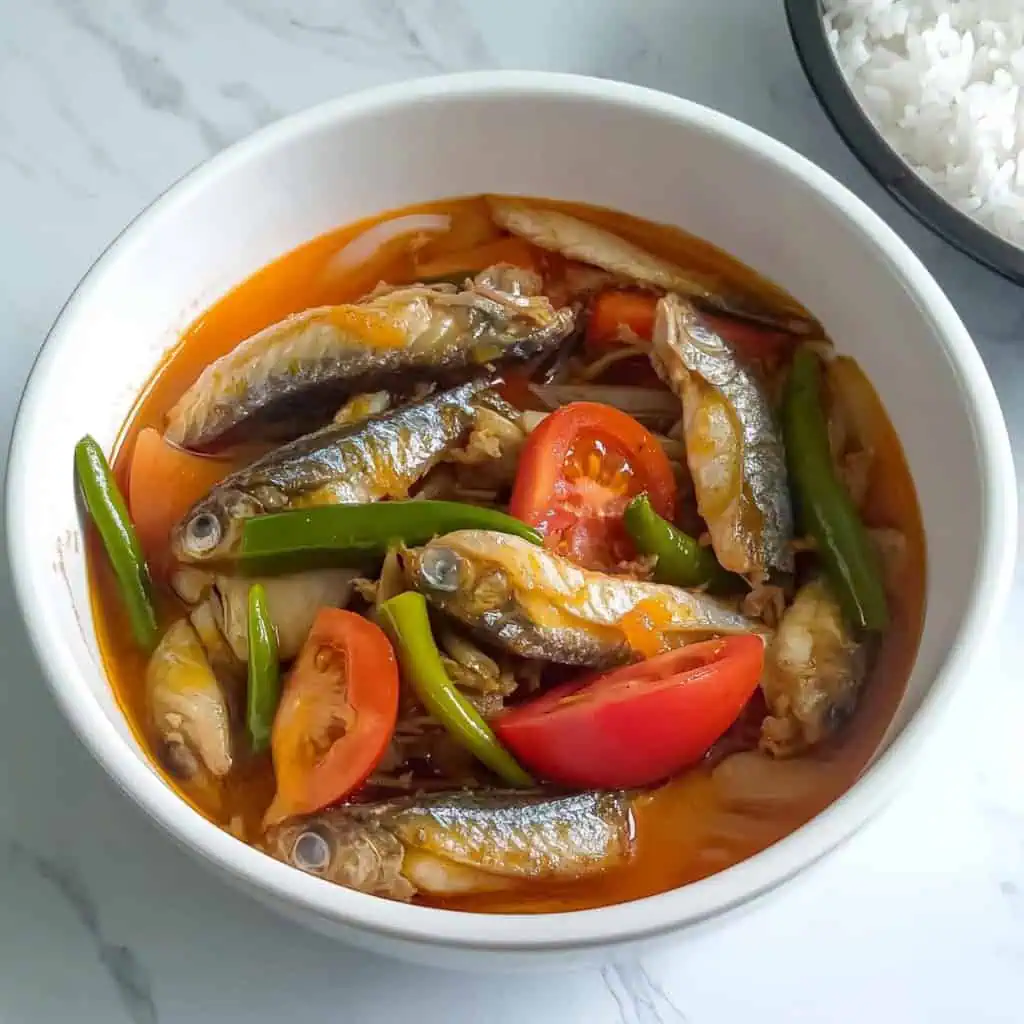









Comments
No Comments